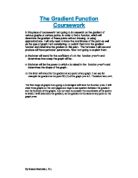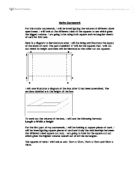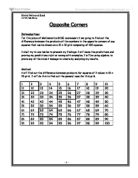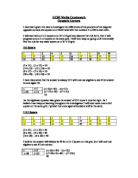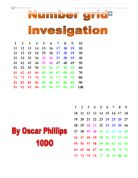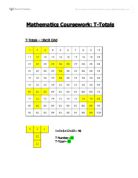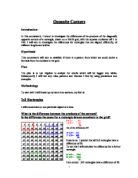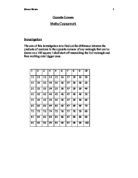opposite corners
Maths Coursework: Opposite Corners Opposite Corners: Introduction: My algebra coursework is about opposite corners in a square in a number grid. The top right and the bottom left numbers are multiplied and the same is done with the top left and bottom right numbers. The difference is calculated between the 2 products and the answer is used to find a pattern. The size of the square will be changed, 2x2, 3x3 and 4x4, to see whether the answers left will help to determine whether or not there is a pattern. 0x10 Grid: I am starting off by using a 10x10 and within this grid I will outline 2x2 squares, 3x3 squares and 4x4 squares. With these squares I will work out the opposite corners in order to see whether or not there is a pattern. 2 3 4 5 6 7 8 9 0 1 2 3 4 5 6 7 8 9 20 21 22 23 24 25 26 27 28 29 30 31 32 33 34 35 36 37 38 39 40 41 42 43 44 45 46 47 48 49 50 51 52 53 54 55 56 57 58 59 60 61 62 63 64 65 66 67 68 69 70 71 72 73 74 75 76 77 78 79 80 81 82 83 84 85 86 87 88 89 90 91 92 93 94 95 96 97 98 99 00 2x2 Squares: 2 3 4 5 6 7 8 9 0 1 2 3 4 5 6 7 8 9 20 21 22 23 24 25 26 27 28 29 30 31 32 33 34 35 36 37 38 39 40 41 42 43 44 45 46 47 48 49 50 51 52 53 54 55 56 57 58 59 60 61 62 63 64 65 66 67 68 69 70
Number Grid Aim: The aim of this investigation is to formulate an algebraic equation that works out the product of multiplying diagonally opposite corners of a particular shape and finding the difference between the results
Mathematics Coursework Number Grid Aim: The aim of this investigation is to formulate an algebraic equation that works out the product of multiplying diagonally opposite corners of a particular shape and finding the difference between the results. I will start off by working this out on a 2x2 square in a 10 x 10 grid and then will investigate varying the widths and lengths of squares and rectangles. Method: In order to simplify the process, the investigation has been divided into sections according to the size of squares in the grids. 2 x 2 Squares To begin with, I used a 10 x 10 grid, looking at 2 x 2 squares: 2 3 4 5 6 7 8 9 0 1 2 3 4 5 6 7 8 9 20 21 22 23 24 25 26 27 28 29 30 31 32 33 34 35 36 37 38 39 40 41 42 43 44 45 46 47 48 49 50 51 52 53 54 55 56 57 58 59 60 61 62 63 64 65 66 67 68 69 70 71 72 73 74 75 76 77 78 79 80 81 82 83 84 85 86 87 88 89 90 91 92 93 94 95 96 97 98 99 00 Then I took 2 x 2 squares from this grid and multiplied the opposing corners to calculate the difference between the two products. 2 1 2 x 12 = 12 2 x 11 = 22 ? 22 - 12 = 10 So the difference between the answers is 10. I then took another 2 x 2 box from the above 10 x 10 grid: 47 48 57 58 47 x 58 = 2726 48 x 57 = 2736 ? 2736- 2726 = 10 The difference is 10 again. Perhaps this
I am going to investigate by taking a square shape of numbers from a grid, and then I multiply the opposite corners to find the difference of these two results. Firstly I am going to start with a 10x10 grid
Gcse Math's - number grid coursework I am going to investigate by taking a square shape of numbers from a grid, and then I multiply the opposite corners to find the difference of these two results. Firstly I am going to start with a 10x10 grid and pick up 4 different squares, I will start with the 2x2 square. Then I move on and use the 3x3, 4x4 and the 5x5 square. number Left corner x right corner Right corner x left corner Products difference 3x24=312 4x23=322 0 2 4x25=350 5x24=360 0 3 25x36=900 26x35=910 0 I have noticed that the products difference of 2x2 squares in a 10x10 grid equal to 10. I predict if I move the 2x2 square to the right or down I will get the same answer. 4 34x45=1530 35x44=1540 0 My prediction is right. I am going to use algebra to test my results. n n+1 n+10 n+11 (n+1)(n+10)=n²+10+11n n(n+11)=n²+11n Products difference is equal to (n²+10+11n) - (n²+11n) =10 In the same grid I will now work out a 3x3 square. number Left corner x right corner Right corner x left corner Products difference 5 5x37=555 7x35=595 40 6 6x24=144 4x26=104 40 7 6x38=608 8x36=648 40 I have noticed that the products difference of 3x3 squares in a 10x10 grid equal to 40. I predict if I move the 3x3 square to the right or up I will get the same answer. 8 26x48=1248 28x46=1288 40 My prediction is right. I am going to
The Gradient Function Coursework
The Gradient Function Coursework In this piece of coursework I am going to do research on the gradient of various graphs at various points, in order to find a function, which will determine the gradient of these points without drawing or using approximations. I will only need to know the coordinates of the point as well as the type of graph I am considering, to submit them into the gradient function and determine the gradient at this point. The formulae I will use and produce will have particular parameters. Now I am going to explain them. a: this letter will stand for the coefficient of x in the function y=ax^n and determines how steep the graph will be. n: this letter will be the power to which x is raised in the function y=ax^n and determines the shape of the graph. m: this letter will stand for the gradient at any point of any graph. I can say for example the gradient at the point P(1;1) of the graph y=x is 1. Therefore here m=1. The first range of graphs I am going to investigate will have the function y=ax. I will draw three graphs on the next pages and hope to see a pattern between the gradient and the function of the graphs. I do not need to consider the coordinates of the points at which I will determine the gradient, as the gradient is the same at any point on the graph y=ax. From these three graphs I clearly recognise a pattern. I will show how I noticed
T-total coursework
Part 1 Investigate the relationship between the T-total and the T-number 2 3 4 5 6 7 8 9 0 1 2 3 4 5 6 7 8 9 20 21 22 23 24 25 26 27 28 29 30 31 32 33 34 35 36 37 38 39 40 41 42 43 44 45 46 47 48 49 50 51 52 53 54 55 56 57 58 59 60 61 62 63 64 65 66 67 68 69 70 71 72 73 74 75 76 77 78 79 80 81 2 3 0 1 2 9 20 21 The T-number is always the number at the bottom of the T, so in this case (the yellow T) it is 20. The sum of all the numbers in the T is the T-total. In this case, the T-number, (which will now be called n) is 20, and the T-total, (which will now be called T) is 37. If the number at the bottom of the T is n, these are the other numbers in terms of n, bearing in mind that the width of the grid is 9 (by 9): n-19 n-18 n-17 0 n-9 2 9 n 21 The number above the T-number is (n-9) because this number is exactly one row above (n). The width of the grid is 9, so by moving up 1 cell from (n), I am decreasing the value by the width of the grid (9). The cell above (n-9) is (n-18) as the value has been decreased by the width of the grid again. The cell to the left of (n-18) is (n-19) as it has been decreased by 1. The cell to the right of (n-18) is (n-17) as it is 1 more than (n-18). When these 5 terms are added together I get: (n) + (n-9) + (n-17) + (n-18) + (n-19) = 5n - 63
I am going to investigate taking a square of numbers from a grid, multiplying the opposite corners and finding the difference of these two results. To start I used a 5x5 grid:
Maths Coursework Number Grids I am going to investigate taking a square of numbers from a grid, multiplying the opposite corners and finding the difference of these two results. To start I used a 5x5 grid: 2 3 4 5 6 7 8 9 0 1 2 3 4 5 6 7 8 9 20 21 22 23 24 25 Then I took 2x2 squares out of this grid and multiplied the opposite corners, to find the difference: 2 6 7 x 7 = 7 2 x 6 = 12 2 - 7 = 5 So the difference between the answers is 5. Next I took another 2x2 square from the same grid. 9 20 24 25 9 x 25 = 475 20 x 24 = 480 480 - 475 = 5 The difference is 5 again. I thought this could mean that all 2x2 squares in a 5x5 grid would come out with a difference of 5. To check this, I took another 2x2 square out of the grid to check. 2 3 7 8 2 x 18 = 216 3 x 17 = 221 221 - 216 = 5 So this shows that my prediction was right and every 2x2 square in a 5x5 grid should come out with a difference of 5. Any 2x2 square in a 5x5 grid = Difference of 5 Now I am going to start taking 2x2 squares out of a 6x6 grid. 2 7 8 x 8 = 8 2 x 7 = 14 4 - 8 = 6 The difference is 6. 21 22 27 28 21 x 28 = 588 22 x 27 = 594 594 - 588 = 6 Again the difference is 6. So I can see like in the 5x5 grid there is a pattern. If I am right every 2x2 square in a 6x6 grid should have a difference of 6. To check if I am right I will take one more square
Opposite Corners. In this coursework, to find a formula from a set of numbers with different square sizes in opposite corners is the aim. The discovery of the formula will help in finding solutions to the tasks ahead as well as patterns involving Opposite
Introduction: The mathematical investigations that are about to be undertaken are all under one puzzle called Opposite Corners. In this coursework, to find a formula from a set of numbers with different square sizes in opposite corners is the aim. The discovery of the formula will help in finding solutions to the tasks ahead as well as patterns involving Opposite Corners. There are a few basic procedures to follow to achieve a basic understanding of the whole puzzle. A box consisting of numbers from 1 to 100, a 10 by 10 grid (arranged in a regular pattern) will aid in initiating an understanding for this piece. Procedure: . Place borders of four lines in order to enclose numbers arranged in a given grid. The enclosed numbers should form a perfect square. 2. Multiply the numbers that are found diagonally opposite and placed in the four corners of the box. 3. From the products obtained after multiplying, find the difference between them. An example is demonstrated on the next page. Below is a 10 by 10 grid. Here the numbers are arranged in 10 columns. 2 3 4 5 6 7 8 9 0 1 2 3 4 5 6 7 8 9 20 21 22 23 24 25 26 27 28 29 30 31 32 33 34 35 36 37 38 39 40 41 42 43 44 45 46 47 48 49 50 51 52 53 54 55 56 57 58 59 60 61 62 63 64 65 66 67 68 69 70 71 72 73 74 75 76 77 78 79 80 81 82 83 84 85
Maths Coursework
Maths Coursework For this maths coursework, I will be investigating the volume of different sized open boxes. I will look at the different sizes of the squares to see which gives the biggest volume. I am going to be using both square and rectangular sheets of card for this task. Here is a diagram to demonstrate what I will be doing and illustrate the layout of the sheet of card. The parts labelled 'x' will be the squares that I will cut out which its height and sizes will be identical as the other cut out squares. x x x x x x x x I will now illustrate a diagram of the box after it has been assembled. The sections labelled x is the height of the box. To work out the volume of the box, I will use the following formula: Length x Width x Height For the first part of my coursework, I will be looking at square pieces of card. I will be investigating square pieces of card and study the relationships between the different sized square cut outs. I am going to look for the square cut out which gives the highest volume overall out of all the rectangles. The squares of sizes I will look at are: 12cm x 12cm, 15cm x 15cm and 18cm x 18cm. The first square I will look at
Mathematics Coursework: problem solving tasks
My name is.....................; I am currently attending the ................ Amongst the various subjects I am undertaking this year, is GCSE mathematics. My coursework assignment asks that I seek to stipulate a formula that will help me establish exactly the required amount of spacers necessary for different arrangements of tiles. I feel the use of diagrams will be useful to depict different arrangements of tiles. Only from these arrangements, will I then be able to collect related information which will then assist me to compile a set of results. Subsequently; I will then organize my results systematically in table form and hopefully from this table I will become aware of a pattern beginning to form. Once I recognize this pattern, I can then determine a suitable formula as a way to work out the required amount of spacers needed for each tile arrangement without having to draw out all diagrams manually. A formula is a rule written in symbols and letters. Spacers are used when tiling a wall, to make sure the tiles are evenly spaced in straight lines, and that the grout between the tiles is of even thickness. Three types of spacers are used when tiling a wall, these include; * T spacer * + spacers & * L spacers My Prediction 'The L shape spacers required for each tile arrangement will always be 4' Results Table I made a table to show my results in a clear way
OPPOSITE CORNERS
Opposite Corners Introduction: For this piece of Mathematics GCSE coursework I am going to find out the difference between the products of the numbers in the opposite corners of any squares that can be drawn on a 10 x 10 grid composing of 100 squares. I shall try to use tables to present my findings; I will make the predictions and proving my predictions right or wrong with examples. I will be using algebra to prove any of the rules I manage to create by analysing my results. Method: I will find out the difference between products for squares of 2 values in 10 x 10 grid. I will do this to find out the general case for this grid. 2 3 4 5 6 7 8 9 0 1 2 3 4 5 6 7 8 9 20 21 22 23 24 25 26 27 28 29 30 31 32 33 34 35 36 37 38 39 40 41 42 43 44 45 46 47 48 49 50 51 52 53 54 55 56 57 58 59 60 61 62 63 64 65 66 67 68 69 70 71 72 73 74 75 76 77 78 79 80 81 82 83 84 85 86 87 88 89 90 91 92 93 94 95 96 97 98 99 00 Example 1: 2 1 2 (11 x 2) - (1 x 12) = 22 - 12 = 10 Example 2: 25 26 35 36 (35 x 26) - (25 x 36) = 910 - 900 = 10 Example 3: 63 64 73 74 (73 x 64) - (63 - 74) = 4672 - 4662 = 10 So, from the above examples I can see that the difference is 10, now I will find out the general case algebraically. GENERAL CASE: n n + 1 n + 10 n + 11 (n + 10)(n






